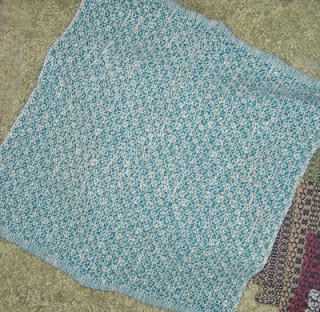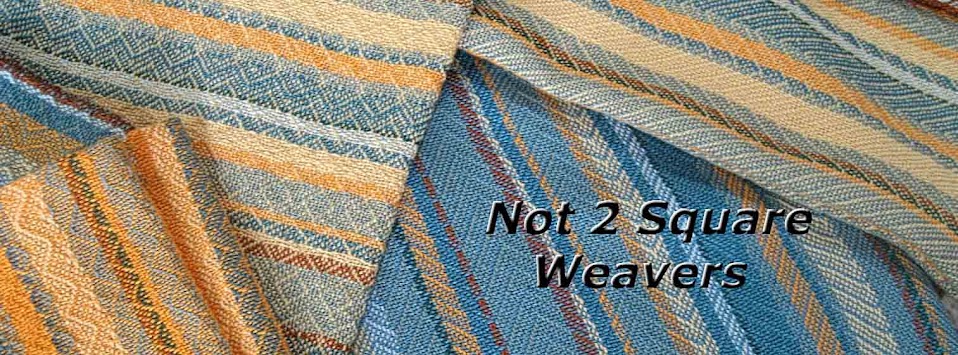 The napkin exchange finally took place after having been postponed for a couple of months. Here are the napkins Gus wove using the bumberet draft featured several blog posts ago. The colors for each set were different and she designed the stripe variations as she wove.
The napkin exchange finally took place after having been postponed for a couple of months. Here are the napkins Gus wove using the bumberet draft featured several blog posts ago. The colors for each set were different and she designed the stripe variations as she wove. Sue H. brought the colorful stack of napkins pictured above. She used 8/2 cottons from her stash and warped two threads at a time in colors that were very close in color. This added attention to detail gives the napkins lots of color depth.
Sue H. brought the colorful stack of napkins pictured above. She used 8/2 cottons from her stash and warped two threads at a time in colors that were very close in color. This added attention to detail gives the napkins lots of color depth. Sue R. wove these two pairs of napkins in soft, natural colors. Sue used her four shaft loom and even though Sue is a relatively new weaver, they are superbly designed.
Sue R. wove these two pairs of napkins in soft, natural colors. Sue used her four shaft loom and even though Sue is a relatively new weaver, they are superbly designed. Marcy's napkins were also woven on her 4 shaft loom. She used a different color weft on each pair and what a variety she came up with. My particular favorites were the set woven with dark red weft.
Marcy's napkins were also woven on her 4 shaft loom. She used a different color weft on each pair and what a variety she came up with. My particular favorites were the set woven with dark red weft. Diana brought three sets -- all different. If you look at past blog posts, you will find the source for the celtic knot pattern and for the blue and white design. The magenta napkins were woven as a sampling journey using different tie ups with her new 8 shaft Mighty Wolf.
Diana brought three sets -- all different. If you look at past blog posts, you will find the source for the celtic knot pattern and for the blue and white design. The magenta napkins were woven as a sampling journey using different tie ups with her new 8 shaft Mighty Wolf. This is one of Dee's napkins. It looks like a two block twill to me and if I'm wrong -- I'll correct myself. These look like they will be very absorbent and I added a pair to my collection.
This is one of Dee's napkins. It looks like a two block twill to me and if I'm wrong -- I'll correct myself. These look like they will be very absorbent and I added a pair to my collection. These are one of my two sets (Beryl) and I have featured the material on Banner Mountain Textiles blog.
These are one of my two sets (Beryl) and I have featured the material on Banner Mountain Textiles blog. Dee brought this bag (the handle is still being knitted) that was woven with an 8/2 cotton warp and with one shot of Sari silk and one shot of cotton in plain weave. This technique made a more supple material than weaving the sari silk every shot.
Dee brought this bag (the handle is still being knitted) that was woven with an 8/2 cotton warp and with one shot of Sari silk and one shot of cotton in plain weave. This technique made a more supple material than weaving the sari silk every shot. At last month's meeting, Jackie showed us some textured yardage that she wove for a future garment. The 8 shaft draft is a two block threading. Block One 1-2-3-4 and Block Two 5-6-7-8. I've just posted the tie up here and you will see that the draft is a two block twill except that the diagonal lines are not turnd in direction. The effect in woven cloth is one of texture, rather than pronounced pattern. Dee wove two scarves and a shawl using this draft. The scarves were treadled 1-2-3-4-5-6-7-8.
At last month's meeting, Jackie showed us some textured yardage that she wove for a future garment. The 8 shaft draft is a two block threading. Block One 1-2-3-4 and Block Two 5-6-7-8. I've just posted the tie up here and you will see that the draft is a two block twill except that the diagonal lines are not turnd in direction. The effect in woven cloth is one of texture, rather than pronounced pattern. Dee wove two scarves and a shawl using this draft. The scarves were treadled 1-2-3-4-5-6-7-8. For this fantastic shawl, Dee did treadle in blocks. The lines are faint between block changes , but more obvious when viewed from a distance.
For this fantastic shawl, Dee did treadle in blocks. The lines are faint between block changes , but more obvious when viewed from a distance.Ingrid has promised that her napkins will be forthcoming and she will do trades with several people once they are completed. By the way, her towels in the slide show were woven on her new 24 shaft loom but they are a 16 shaft point twill design (they are the dark green and white diamonds).
Be back next month for more virtual "show and tell"













































